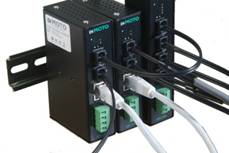POF in Industrial Networks
Industrial controls have been taking advantage of the unique properties of plastic optical fiber for decades. An industrial network can be broken down into three distinct layers: A device network, a control network, and a corporate network. Each layer operates in a different environment that has different requirements to ensure reliable communication. In the face of unqanted interference from ground loops and electromagnetic interference (EMI) generated by factory equipment, designers use POF to preserve and protect data links between PLCs, controllers, and workstations.
Ethernet is the dominant standard for commercial local area networks, and is gaining populatiry in industrial and process control networks. Among the protocols that support POF networks are IEEE 1394, SERCOS, ModBus/TCP, ProfiNet (ProfiBus on Ethernet), Ethernet/IP, Foundation Fieldbus High-Speed Ethernet, ODVA, and the time-tested RS-232 serial protocol.

Systems use Ethernet over POF encode data using the IEEE 802.3u 100Base-FX standard. DiMoto, one of FiberFin’s many suppliers, is an Australian-based manufacturer of industrial Ethernet media converters. These are compliant with both 100Base-FX and 10/100Base-T, and convert signals between copper and POF. They are designed to provide interoperability with all compliant network devices, including switches, routers, hubs, and computers.